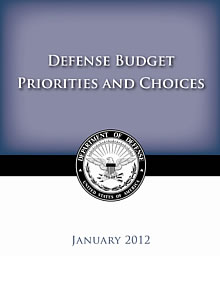Budget Blunder: “No Cuts” in Nuclear Forces
 |
| The new defense budget has “no cuts” in nuclear forces. |
.
By Hans M. Kristensen
“There are no cuts made in the nuclear force in this budget.” That clear statement was made yesterday by deputy defense secretary Ashton Carter during the Pentagon’s briefing on the defense budget request for Fiscal Year 2013.
We’ll have to see what’s hidden in the budget documents once they are released next month, but the statement is disappointing for anyone who had hopes that the administration’s promises about “concrete steps” to reduce the number and role of nuclear weapons and to “put an end to Cold War thinking” would actually be reflected in the new defense budget.
Not so for the FY13 budget. Other than a decision to delay work for two years on the next generation ballistic missile submarine, the Defense Budget Priorities and Choices report released yesterday does not list any nuclear reductions; neither previously announced nor new ones.
But one year after the New START treaty entered into effect and 18 months after the Nuclear Posture Review was completed, it would have made sense to include some nuclear cuts in this budget – especially because this budget includes programming for future budget years through 2017, only one year before the New START treaty has to be implemented. Specifically, the Pentagon should have explained how (and how soon) it will achieve the previously announced plans to:
- Reduce the number of nuclear bombers to 60 deployed aircraft;
- Reduce the number of ICBMs to no more than 420 deployed missiles;
- Reduce the number of SLBMs to no more than 240 deployed missiles;
- Retire the nuclear Tomahawk cruise missile.
Why wait? Demonstrating that the U.S. is not only talking about reducing its nuclear forces but also doing so through near term defense budget cuts would have been an important signal to other nuclear weapon states whose militaries are waiting to see what has changed in the U.S. nuclear posture. It would also have been an important signal to the countries in the international nuclear nonproliferation regime that will convene in May to prepare for the next review of the nuclear Non-Proliferation Treaty, countries whose support we need to strengthen the nonproliferation regime.
Instead, the administration might now have to spend a good part of the next year saying: “Trust us, we’re working on it.”
And it is working on it. The most important effort is the review currently underway within the administration of the requirements for targeting and alert levels of nuclear forces – requirements that determine the force level. The review may well decide additional reductions beyond New START.
In a hint to what might come, the new defense strategic guidance published in early January stated: “It is possible that our deterrence goals can be achieved with a smaller nuclear force, which would reduce the number of nuclear weapons in our inventory as well as their role in U.S. national security strategy.” (Emphasis in original.)
The Defense Budget Priorities and Choices document appears to reaffirm this by stating that the White House review “will address the potential for maintaining our deterrent with a different nuclear force.”
Once the deterrence review is completed, it is important that the White House explains to the world what it has decided and doesn’t leave it to leaks and vague comments by anonymous officials to determine what the international perception of the direction of the U.S. nuclear posture will be.
This publication was made possible by a grant from Carnegie Corporation of New York and Ploughshares Fund. The statements made and views expressed are solely the responsibility of the author.
Satellite imagery has long served as a tool for observing on-the-ground activity worldwide, and offers especially valuable insights into the operation, development, and physical features related to nuclear technology.
This report outlines a framework relying on “Cooperative Technical Means” for effective arms control verification based on remote sensing, avoiding on-site inspections but maintaining a level of transparency that allows for immediate detection of changes in nuclear posture or a significant build-up above agreed limits.
The grant comes from the Carnegie Corporation of New York (CCNY) to investigate, alongside The British American Security Information Council (BASIC), the associated impact on nuclear stability.
Satellite imagery of RAF Lakenheath reveals new construction of a security perimeter around ten protective aircraft shelters in the designated nuclear area, the latest measure in a series of upgrades as the base prepares for the ability to store U.S. nuclear weapons.